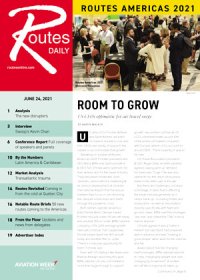
This article first featured in Routes Daily magazine, published on June 24 during Routes Americas 2021.
When Breeze Airways took to the skies for the first time in May, the carrier became the second US airline to launch in as many months, following Avelo.
Both are offering low fares, promising reliable service, and flying routes with limited or no competition. And, while the air transport industry is still in recovery, the leaders at these new carriers believe the timing is right to take a slice of the leisure-dominated demand created by the crisis.
The strategies of Breeze and Avelo are similar—each employing tactics that have served other LCCs well—but there are clear differences. Avelo CEO Andrew Levy is steering his airline closer to former employer Allegiant’s model, while Breeze CEO David Neeleman is positioning closer to JetBlue, which he founded.
Avelo, based at Hollywood Burbank (BUR), is taking the ULCC approach, providing a stripped-down service. Quick turnarounds and high aircraft utilization are the name of the game. Three 189-seat Boeing 737-800s are being operated, with three 737-700s scheduled to join its fleet. The focus is on smaller cities and secondary airports in larger metro areas, such as Phoenix-Mesa (AZA).
All 11 routes from BUR are unserved, with destinations like Bozeman (BZN) in Montana, Eugene (EUG) in Oregon, and Ogden (OGD) in Utah highlighting an emphasis on “outdoor recreation, national parks, and coastal and mountain terrain.”
In total there are 98 weekly departures and around 18,500 weekly seats available. Analysis shows that the average route distance is 622 mi. (1,001 km) and the average flight time is 74 minutes.
Connecticut’s Tweed New Haven Airport (HVN) will become Avelo’s second base during the third quarter. New Haven, a coastal city located around 85 mi. from New York and home to Yale University, has a sizeable catchment of about 5.5 million people, nearly all of whom drive elsewhere to fly. The only flights offered from the airport are to Philadelphia (PHL). However, O&D demand from HVN is skewed heavily toward Florida, with Miami, Orlando and Tampa historically strong. It seems likely Avelo will look to this market.
Already ensconced in the US Sunbelt is Breeze, which has concentrated on linking secondary markets to leisure destinations, bypassing hubs. The airline has focused its attention on Tampa (TPA), Charleston (CHS), Norfolk (ORF) and New Orleans (MSY).
A total of 39 routes in the Southwest, Midwest, Southeast and Eastern US will be offered during the Salt Lake City-headquartered carrier’s first phase of expansion, with flights beginning to all 16 destinations by July 22.
Service will be operated onboard 13 leased single-class Embraer aircraft this summer, serving routes with an average flight length of just over an hour. Ten E190 jets will be configured to seat 108 passengers, while three E195 aircraft will have 118 seats.

Routes Daily
Analysis of Breeze’s network shows that 31 of the 39 routes are without any direct competition, and Neeleman claims 100 other unserved city pairs are under consideration. He also believes that competition with LCCs will be limited because the Embraers allow it to enter much smaller markets.
However, while the airline’s E-Jets flying connects secondary short-haul leisure markets, the 60 Airbus A220-300s that Breeze has on order will be deployed on longer, thinner routes. The first A220s will feature a premium cabin—dubbed its “nicest” product—and are expected to arrive in October.
With Neeleman hoping to stretch the range of the Airbus jets up to 4,000 nm—an increase of about 600 nm over the current official maximum design range—possible markets could include destinations in the Caribbean and Latin America, as well as the potential for transatlantic service.
While it’s still early days for both Breeze and Avelo, both are well capitalized and have clearly defined strategies about how they intend to take on the majors. Time will tell if the next wave of disruption is already underway.
Photo credit: Patrick T. Fallon / AFP / Getty Images





